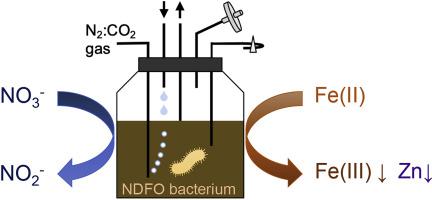Chemosphere ( IF 8.1 ) Pub Date : 2020-08-01 , DOI: 10.1016/j.chemosphere.2020.127838 Kazuki Jokai 1 , Tomomi Nakamura 1 , Satoshi Okabe 1 , Satoshi Ishii 2

|
Nitrogen and heavy metals can co-occur in various industrial wastewaters such as coke-oven wastewater. Removal of these contaminants is important, but cost-efficient removal technology is limited. In this study, we examined the usefulness of nitrate-dependent ferrous iron oxidation (NDFO) for the simultaneous removal of nitrate and heavy metals (iron and zinc), by using an NDFO strain Pseudogulbenkiania sp. NH8B. Based on the batch culture assays, nitrate, Fe, and Zn were successfully removed from a basal medium as well as coke-oven wastewater containing 5 mM nitrate, 10 mM Fe(II), and 10 mg/L Zn. Zinc in the water was most likely co-precipitated with Fe(III) oxides produced during the NDFO reaction. Simultaneous removal of nitrate, Fe, and Zn was also achieved in a continuous-flow reactor fed with a basal medium containing 10 mM nitrate, 5 mM Fe(II), 4 mM acetate, and 10 mg/L Zn. However, when the reactor is fed with coke-oven wastewater supplemented with 10 mM nitrate, 5 mM Fe(II), 4 mM acetate, and 10 mg/L ZnCl2, the reactor performance significantly decreased, most likely due to the inhibition of bacterial growth by thiocyanate or organic contaminants present in the coke-oven wastewater. Use of mixed culture of NDFO bacteria and thiocyanate/organic-degrading denitrifiers should help improve the reactor performance.
中文翻译:

在连续流动的硝酸盐依赖性亚铁氧化(NDFO)生物反应器中同时去除硝酸盐和重金属。
氮和重金属可同时存在于各种工业废水中,例如焦炉废水。去除这些污染物很重要,但是具有成本效益的去除技术受到限制。在这项研究中,我们通过使用NDFO菌株Pseudogulbenkiania,研究了硝酸盐依赖性亚铁氧化(NDFO)在同时去除硝酸盐和重金属(铁和锌)方面的有用性。sp。NH8B。根据分批培养测定法,成功地从基础培养基以及含5 mM硝酸盐,10 mM Fe(II)和10 mg / L Zn的焦炉废水中成功去除了硝酸盐,Fe和Zn。水中的锌最有可能与NDFO反应过程中产生的Fe(III)氧化物共沉淀。在连续流反应器中,同时加入含10 mM硝酸盐,5 mM Fe(II),4 mM乙酸盐和10 mg / L Zn的基础介质,还可以同时去除硝酸盐,Fe和Zn。但是,当向反应器中加入焦炉废水时,该废水需补充有10 mM硝酸盐,5 mM Fe(II),4 mM乙酸盐和10 mg / L ZnCl 2,反应器性能显着下降,最有可能是由于焦炉废水中存在的硫氰酸盐或有机污染物抑制了细菌的生长。NDFO细菌和硫氰酸盐/有机降解反硝化剂的混合培养应有助于提高反应器性能。











































 京公网安备 11010802027423号
京公网安备 11010802027423号